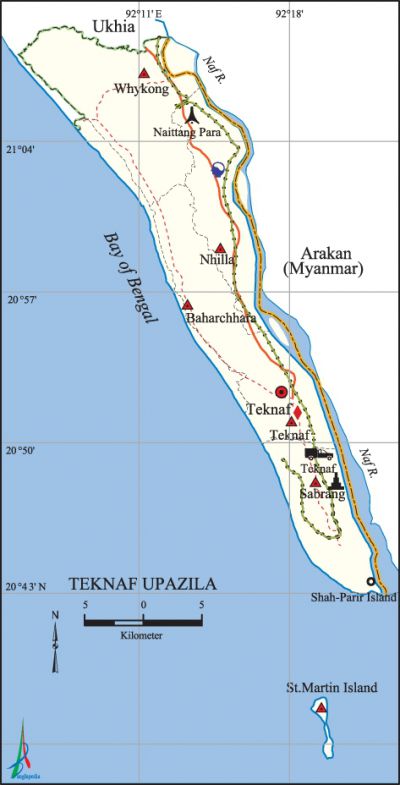Teknaf Upazila
Teknaf Upazila (cox’s Bazar district) area 388.68 sq km, located in between 20°23' and 21°09' north latitudes and in between 92°05' and 92°23' east longitudes. It is bounded by ukhia upazila on the north, the bay of bengal on the south, arakan state of Myanmar on the east, the Bay of Bengal on the west. Teknaf upazila, located on the south east extremity of Bangladesh, is 86 km on the south of Cox's Bazar Town.
Population Total 200607; male 105096, female 95511; Muslim 195040, Hindu 2675, Buddhist 37, Christian 2836 and others 19.
Water bodies Main river: naf.
Administration Teknaf Thana was formed in 1930 and it was turned into an upazila in 1983.
| Upazila | ||||||||
| Municipality | Union | Mouza | Village | Population | Density (per sq km) | Literacy rate (%) | ||
| Urban | Rural | Urban | Rural | |||||
|
1 |
6 |
13 |
131 |
36192 |
164415 |
516 |
29.93 |
23.14 |
| Municipality | |||||
|
Area (sq km) |
Ward |
Mahalla |
Population |
Density (per sq km) |
Literacy rate (%) |
|
4.05 |
9 |
9 |
17569 |
4338 |
40.44 |
| Upazila Town | |||||
|
Area (sq km) |
Mouza |
Population |
Density (per sq km) |
Literacy rate (%) | |
|
31.53 |
1 |
18623 |
591 |
19.53 | |
| Union | ||||
| Name of union and GO code | Area (acre) | Population | Literacy rate (%) | |
| Male | Female | |||
|
Teknaf 63 |
26233 |
18160 |
16377 |
22.54 |
|
Baharchhara 15 |
3782 |
10291 |
9391 |
13.45 |
|
Sabrang 47 |
15582 |
24092 |
22420 |
19.54 |
|
Whykong 79 |
27859 |
20872 |
19002 |
21.14 |
|
Nhilla 31 |
16486 |
19693 |
18209 |
34.02 |
|
St. Martins Dwip 39 |
824 |
2401 |
2130 |
15.13 |
Source Bangladesh Population Census 2001,Bangladesh Bureau of Statistics.

Archaeological heritage and relics Buddhist temple (Naitong Hill), Mathiner Kup (well of Mathin, 1854), Kana Rajar tunnel.
History of the War of Liberation In 1971 the freedom' fighters used to get arms training from Teknaf and the nearby country Myanmar. During the war of liberation the Pak army established a camp at the Teknaf Dakbangalow. They used to abduct innocent people from ramu, Ukhia and Teknaf and tortured them to death at this camp. The Pak army killed about 250 Bangalis in this camp.
Marks of the War of Liberation Mass killing site 1 (Naitang Para).
Religious institutions Mosque 183, temple 7, buddhist keyang 11. Noted religious institutions: Teknaf Bara Mosque, Aliyabad Jami Mosque, Teknaf Bishnu Mandir, Teknaf Buddhist Vihara, Chowdhuripara Buddhist Vihara at Qila.
Literacy rate and educational institutions Average literacy 24.4%; male 29.3%, female 19.1%. Noted educational institutions: Teknaf Government Primary School (1890), Teknaf Pilot High School (1945).
Newspapers and periodicals Defunct: Naf kantha.
Cultural organisations Club 50, cinema hall 1, playground 11.
Tourist spots St. Matin's Island (It is located 12 km from the main land and is the only coral island of Bangladesh). St. Martin's Island is comprised with four islands such as Zinzira, Dakshin Para, Chhalchhira and Bechhadia. The total area of the island is 4.8 km).
Main sources of income Agriculture 44.95%, non-agricultural labourer 6.51%, commerce 21.88%, transport and communication 1.96%, service 4.27%, construction 0.79%, religious service 0.36%, rent and remittance 2.46% and others 16.82%.
Ownership of agricultural land Landowner 27.34%, landless 72.66%; agricultural landowner: urban 18.86% and rural 29.28%.
Main crops Paddy, betel leaf, potato.
Extinct or nearly extinct crops Arahar, onion, mustard, wheat.
Main fruits Mango, jackfruit, banana, papaya, coconut, betel nut.
Fisheries, dairies and poultries Fishery 255 (shrimp cultivation), demonstration shrimp farm and training centre 1, dry fish farm 6, poultry 8, hatchery 7.
Communication facilities Pucca road 45 km, semi-pucca road 34.50 km, mud road 172.50 km.
Extinct or nearly extinct traditional transport Palanquin, bullock cart.
Noted manufactories Ice factory 3, salt mill 1.
Cottage industries Goldsmith 153, blacksmith 50, potteries 150, bamboo, cane and wood work 525, tailoring 250.
Hats, bazars and fairs Hats and bazars are 13, fairs 1, most noted of which are Sabrang Hat, Shah Parir Dwip Hat, Whykong Bazar and Qila Bazar.
Main exports Betel nut, betel leaf, fish, salt.
Access to electricity All the wards and unions of the upazila are under rural electrification net-work. However 17.91% of the dwelling households have access to electricity.
Sources of drinking water Tube-well 81.78%, tap 0.96%, pond 9.61% and others 7.65%.
Sanitation 36.15% (rural 29.20% and urban 66.44%) of dwelling households of the upazila use sanitary latrines and 38.95% (rural 43.83% and urban 17.68%) of dwelling households use non-sanitary latrines; 24.90% of households do not have latrine facilities.
Health centres Upazila health complex 1, satellite clinic 2, family planning centre 3, cholera hospital 1.
Natural disasters Many people were victims of the cyclones of 29 April 1991 and 30 May 1997. Besides, these natural disasters also caused heavy damages to settlements, livestock and other properties of the upazila.
NGO activities Operationally important NGOs are brac, Red Crescent Society. [Md. Mainuddin]
References Bangladesh Population Census 2001, Bangladesh Bureau of Statistics; Cultural survey report of Teknaf Upazila 2007.
